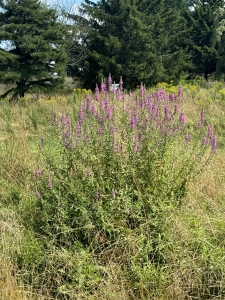Join us at Viles Arboretum on August 24th for a crucial volunteer event focused on removing the invasive plant Purple loosestrife (Lythrum salicaria), a striking but problematic plant species poses a significant threat to native plants and wildlife, disrupting the delicate ecosystem balance of our wetlands and habitats across the state. Here’s what you need to know about this perennial herb, its impact on local ecosystems, and strategies for managing its spread.

Description
Purple loosestrife is a robust, perennial herb that can grow between 4 to 6 feet tall. At the base of mature plants, the stem feels woody. Its leaves are simple, arranged opposite or in whorls, lanceolate to oblong in shape, and have entire margins. The plant produces long, crowded spikes of deep pink-purple flowers with 5 to 7 petals, each about ½ to ¾ inch wide. These flowers bloom from mid to late summer in Maine, with asynchronous flowering where the bottom of the spikes open first. The fruit is a brown, dry capsule that persists on the stem, while the stem itself is notably four-angled.
Native Range and Arrival in the U.S.
Purple loosestrife is native to Europe and Asia. It arrived in the U.S. both as an ornamental plant and as a contaminant in ballast, livestock bedding, and possibly wool.
Reproduction and Spread
This plant reproduces through seeds, which remain viable for several years. Seeds can be transported by water, floating for up to three days, or they may hitchhike on wildlife, soil, or fill. This ability to spread makes controlling its population challenging.
Habitat
Purple loosestrife thrives in wetlands, rivershores, lakeshores, and other wet open areas such as roadsides, agricultural swales, and powerline corridors. It can tolerate saturated conditions, including organic/peat and damp mineral soils, and is most prolific in full sun but can also survive in partial shade.
In a 2005 study, Purple Loosestrife presence was found to negatively affect American Toad tadpoles. “Dramatic and rapid mortality” was observed in toad tadpoles exposed to the plant. The suspected mechanism of mortality was decomposing loosestrife leaves leaching tannins into the water which can damage the gills of developing tadpoles. With high tadpole mortality rates, entire populations of American toads in an area invaded by this plant could be at risk. American Toads are important as a species and for their role in the ecosystem, and their continued survival is threatened by Purple Loosestrife.
Control Methods
Managing purple loosestrife requires persistence and a multi-faceted approach:
- Manual Removal: Small plants or isolated individuals can be dug up by the roots when the soil is moist. However, re-sprouting may occur.
- Cutting and Pulling: Persistent cutting or pulling multiple times during the growing season over several years (at least 3 times per year for 3 years) before flowering may eventually kill the plant.
- Herbicides: Foliar Applications: Aquatic glyphosate solutions or foliar applications of aquatic triclopyr can effectively control loosestrife, particularly in aquatic settings; Cut-Drip Applications: Less effective and highly tedious compared to foliar applications, these involve applying herbicide immediately after cutting. Important: Follow all label directions for herbicide use, especially in or near wetlands and water bodies. Consult the Maine Board of Pesticides Control for special regulations.
Resources
Vermont Fact Sheet for Purple Loosestrife
Purple Loosestrife: What You Should Know, What You Can Do
Go Botany Page for Lythrum salicaria
Source: https://www.maine.gov/dacf/mnap/features/invasive_plants/lythrum.htm, https://besjournals.

